About the Possible Limitations in the Usage of the Non-Destructive Ultrasonic Pulse Velocity Method for Assessment of Cracks in Reinforced Concrete Structures, Subjected to Direct Environmental Exposure
Abstract
:1. Introduction
- The integrity of the structural element is preserved.
- There is an ability for measuring locations that are difficult to reach or within considerable distances from the surface of the elements.
- High sensitivity, allowing detection of very small defects.
- Obtaining data on structures that are unsafe.
- Opportunity to study part or all of the structure.
- Evaluation of the effectiveness of reconstructions.
- Repeatability of results.
- Safety for operators.
- Faster execution.
- Saving of materials and equipment.
- Method automation, continuous data recording, integration into information systems.
- Portability of equipment.
- Minor energy consumption.
- Minimal impact on staff.
- Acoustic emission (AE) is a method used for characterization of the crack initiation and propagation mechanisms of a structure in real time. It enables recording of the initiation and spreading of elastic waves of acoustic signals at propagating cracks. Information regarding the location of the cracking sources and their mode can be supplied by proper analysis of acoustic emission. The experience of the user is essential in order to explain the acoustic emissions trends [23].
- The ultrasonic pulse velocity method is based on the propagation of ultrasonic waves in the elements. Short ultrasonic pulse-waves are transmitted into materials to detect internal flaws or to characterize materials. It continues to be an important non-destructive technique, which provides reliable results based on rapid measurements with relatively inexpensive equipment. It has many advantages, such as: it does not affect the appearance or the functioning of the structures under analysis and there is no need for application of cables, fibers, and equipment on the structure; data can be periodically collected from the same test points, making possible the control of variations over time; the ultrasonic pulse velocity can be employed for the detection of cracks but this cannot be used solely and should be accompanied by other techniques for better accuracy and identification of the cracks. The main disadvantages of non-destructive ultrasonic pulse velocity method (NDUPVM) are: it is necessary to have free access to the examined element and surfaces (sometimes it requires a cut in traffic temporary, a need for additional facilities, etc.); results are affected in the case of the elements are exposed on direct external conditions (such as rain, snow, etc.), as the results of this research shows.
- Digital image correlation (DIC) is a non-destructive, non-contact and precise method for crack measurements in reinforced concrete elements [23,24,25,26,27]. This method is of interest for monitoring аt different loading stages in real time. Digital images are taken and by comparing the images it is possible for the crack initiation and crack propagation to be obtained in the object subjected to external loads. It gives a clear depiction of the surface strain field and its transient changes according to stress redistribution which occurs after fracture moments [28]. This method is very effective for measuring the crack growth in concrete. Different pattern that should be printed on the object can be used to get the best results with this method [27]. The main disadvantage is that only the surfaces of the elements can be evaluated. DIC has big advantages to other methods, but it is more appropriate if we start monitoring an element, or even a whole structure from the beginning—after the structure is built and the pattern is printed on an unloaded structure. There are still some limitations for application on existing concrete structures, especially if they have existing cracks.
- Fiber optic crack sensors are used for detecting and monitoring cracks in real time in concrete and reinforced concrete structures, where the crack locations are often not known in apriori. Tiny cracks before visual recognition could be detected with these sensors [28,29,30]. Their advantages are the small weight and dimensions, the strong immunity to electromagnetic interference and the scale flexibility for small-gauge and long-gauge measurements, and they provide high-resolution and measurement capabilities that are not feasible with conventional technologies [30]. They can be placed on the surface or to be embedded in reinforced concrete elements. Fiber optic crack sensors are a powerful tool for detection, even very small cracks, and are useful in many cases, such as usage of high performance concrete, concrete structures, and bridges that should not open cracks during their exploitation, etc., but they are very expensive and they still cannot be used to determine the depth of the cracks.
- Visual observation by crack magnifiers [3,10,11,15,16,17,20] is a conservative and very reliable method. As it is well known that cracks have different patterns, and depths, because of the nature of the concrete (they follow gravels, internal small defects, etc.), the method has the same disadvantage, like DIC, that cracks can be evaluated only on the surfaces of the elements and require a clear access to the elements.
2. Essence of the Non-Destructive Ultrasonic Pulse Velocity Method
- temperature;
- water–cement ratio;
- inclusion of air in the concrete;
- age, type, properties, and parameters of the concrete, through which ultrasonic pulses passes;
- type and size of coarse aggregate (crushed stone, gravel, chemical and/or mineral additives, etc.);
- technology for preparing and laying the concrete mix;
- contact between transducers and the surface of the reinforced concrete element;
- distance between the transducers.
3. Experimental Setup
- Specimens type A had a cross section of 27/15 cm, bottom longitudinal reinforcement 2N12 (steel B500), stirrups ф8/10(15) cm (steel B235).
- Specimens type B had a cross section 27/15 cm, bottom longitudinal reinforcement 2N18 (steel B500), stirrups N8/10(15) cm (steel B500).
- Specimens type C had a cross section 30/15 cm, bottom longitudinal reinforcement 2N12 (steel B500), stirrups ф8/10(15) cm (steel B235).
- Specimens type D had a cross section 30/15 cm, bottom longitudinal reinforcement 2N18 (steel B500), stirrups N8/10(15) cm (steel B500).
4. Results and Discussion
4.1. Measuring the Depth of Normal Cracks
4.2. Results Summary
- At crack depths from 4.5 cm to 14.3 cm measured visually and a crack width from 0.05 mm to 0.30 mm, the relative error was from 0.97% to 61.67%.
- At crack depths from 19.2 cm to 20.2 cm measured visually and crack width from 0.50 mm to 0.60 mm, the relative error was 47.58% to 50.75%.
- At crack depths from 21.1 cm to 25.7 cm measured visually and crack width from 1.10 mm to 1.30 mm, the relative error was 10.14% to 38.49%.
- According to [18], the visually determined crack depths are greater than those determined by the NDUPVM and it was confirmed by the present research.
- Measured values for and had good consistency and the obtained standard deviations were low. It proves that the measurements were properly made.
- The standard deviations for all, but the common crack width of 0.15 mm, values were acceptable for such measurements.
- The biggest value of for the common crack’s width showed that these cracks were mainly affected by external exposure.
5. Conclusions
- The present study confirmed the possibility of using NDUPVM for the assessment of reinforced concrete structures and the possibility for obtaining information about the homogeneity of the reinforced concrete, for detection of caverns and cracks, and assessment of the quality of the construction.
- Measuring, processing, analyzing, and interpreting the obtained results required careful data collection, high qualification of the researchers, and expert analysis.
- All measured crack depths by the NDUPVM were smaller than the real ones.
- This research confirmed that the visually determined crack depths were greater than those determined by the NDUPVM.
- The direct exposure on external atmospheric impacts, such as rain, snow, etc. had an influence on the accuracy of the NDUPVM measurements.
- The relative error varied in a wide range, between 0.97% and 61.67%, and it was not possible to predict the real value of crack depth only by NDUPVM in the case of direct exposure of external atmospheric impacts over the examined structures.
- Further research is required to systematize the methods for detecting defects and cracks in reinforced concrete.
- It is necessary to extend the research on beams with different shape, reinforcement ratio, concrete grade, etc., and on other structural elements, like slabs, columns, walls, etc.
Author Contributions
Funding
Conflicts of Interest
References
- Zaharieva-Gueorguieva, B. Theoretical and Experimental Study of Reinforced Concrete Elements of High Strength Concrete Loaded on Compression and Bending. Ph.D. Thesis, University of Architecture, Civil Eng. and Geodesy (UACG), Sofia, Bulgaria, 1991. [Google Scholar]
- Rusev, K.; Kardjiev, V.; Traykova, M.; Yanchev, V.; Andreev, M.; Nikolova, B.; Barakova, N.; Hristov, P.; Stefanov, G.; Georgiev, E.; et al. Manual on Reinforced Concrete Eurocode 2; Chamber of Engineers in the Investment Design: Sofia, Bulgaria, 2011. [Google Scholar]
- Dimov, D. Non-Destructive Testing of Building Structures; Direct Services: Sofia, Bulgaria, 2011. [Google Scholar]
- Concu, G.; Trulli, N. Concrete Defects Sizing by Means of Ultrasonic Velocity Maps. J. Build. 2018, 8, 176. [Google Scholar] [CrossRef]
- Ivanchev, I.; Slavchev, V. Experimental Determination of Homogeneity, Compressive Strength and Modulus of Elasticity of Concrete in Reinforced Concrete Elements by Non-Destructive Ultrasonic Pulse Velocity Method. In Proceedings of the 16th International Conference on New Trends in Statics and Dynamics of Buildings, Bratislava, Slovakia, 18–19 October 2018; Faculty of Civil Engineering STU Bratislava, Slovak Society of Mechanics SAS: Bratislava, Czechoslovakia, 2018; pp. 179–184, ISBN 978-80-227-4845-2. [Google Scholar]
- Ivanchev, I. Experimental Determination of Concrete Compressive Strength by Non-Destructive Ultrasonic Pulse Velocity Method. Int. J. Res. Appl. Sci. Eng. Technol. 2018, 6, 2647–2651. [Google Scholar] [CrossRef]
- Ivanchev, I. Experimental Determination of Modulus of Elasticity of Concrete by Non-Destructive Ultrasonic Pulse Velocity Method. Int. J. Res. Appl. Sci. Eng. Technol. 2018, 6, 1929–1993. [Google Scholar] [CrossRef]
- Kumar, S.; Santhanam, M. Detection of Concrete Damage Using Ultrasonic Pulse Velocity Method. In Proceedings of the National Seminar on Non-Destructive Evaluation, Hyderabad, Indian Society for Non-Destructive Testing Hyderabad Chapter, Hyderabad, India, 7–9 December 2006; pp. 301–308. [Google Scholar]
- Lorenzi, A.; Tisbierek, F.; Pinto, L. Ultrasonic Pulse Velocity Analysis in Concrete Specimens. In Proceedings of the IV Conferencia Panamericana de END, Buenos Aires, Argentina, 22–26 October 2007. [Google Scholar]
- Kalyan, T.; Chandra Kishen, J. Experimental Evaluation of Cracks in Concrete by Ultrasonic Pulse Velocity. In Proceedings of the APCNDT 2013, Asia Pacific Conference on Non-Destructive Testing (14th APCNDT), Mumbai, India, 18–22 November 2013. [Google Scholar]
- Zatar, W. Assessing the Service Life of Corrosion-Deteriorated Reinforced Concrete Member Highway Bridges in West Virginia; Prepared for the WVDOT/DOH RP# 234; West Virginia Department of Transportation: Charleston, West Virginia, USA, 2014.
- Proceq TICO, Operating Instructions, Ultrasonic Testing Instrument, Proceq SA, Switzerland. 2008. Available online: http://www.abmbv.nl/files/proceq_tico_user_manual_en.pdf (accessed on 1 June 2014).
- Bogas, J.; Gomes, M.; Gomes, A. Compressive strength evaluation of structural lightweight concrete by non-destructive ultrasonic pulse velocity method. Ultrasonics 2013, 53, 962–972. [Google Scholar] [CrossRef] [PubMed]
- Ponchon, A. Determining of Crack Depths in Reinforced Concrete Elements with Non-Destructive Ultrasonic Pulse Velocity Method. In Proceedings of the 16 International Conference on New Trends in Statics and Dynamics of Buildings, Bratislava, Slovakia, 18–19 October 2018. [Google Scholar]
- Omar, M. Nondestructive Testing Methods and New Applications; InTech: Rijeka, Croatia, 2012; ISBN 978-953-51-0108-6. [Google Scholar]
- Introduction to Nondestructive Testing; The American society for Non-Destructive Testing: Columbus, OH, USA, 2019.
- Arne, K.; Crack, C. Depth Measurement in Reinforced Concrete Using Ultrasonic Techniques. Master’s Thesis, Georgia Institute of Technology, Atlanta, GA, USA, 2014. [Google Scholar]
- Panzera, T.; Christoforo, A.; Cota, F.; Borges, P.; Bowen, C. Ultrasonic Pulse Velocity Evaluation of Cementitious Materials. In Advances in Composite Materials—Analysis of Natural and Man-Made Materials; InTech: InTech, Rijeka, Croatia, 2011; ISBN 978-953-307-449-8. [Google Scholar] [Green Version]
- ACI 228.2R-98. Nondestructive Test Methods for Evaluation of Concrete in Structures; ACI Committee 228, Chairman: Davis A.; American Concrete Institute: Farmington Hills, MI, USA, 1998. [Google Scholar]
- Mathey, R.; Clifon, J. Review of Nondestructive Evaluation Methods Applicable to Construction Materials and Structures; NBS Technical Note 1247; U.S. Government Printing Office: Gaithersburg, MD, USA, 1988.
- Ongpeng, J. Non-Destructive Testing Using Ultrasonic Waves in Reinforced Concrete. 2015. Available online: https://www.researchgate.net/publication/282869893_NON-DESTRUCTIVE_TESTING_USING_ULTRASONIC_WAVES_IN_REINFORCED_CONCRETE (accessed on 10 November 2015). [CrossRef]
- Irie, H.; Yoshida, Y.; Sakurada, Y.; Ito, T. Non-destructive-testing Methods for Concrete Structures. NTT Tech. Rev. 2008, 6, 1–8. [Google Scholar]
- Aggelis, D.; Verbruggen, S.; Tsangouri, E.; Tysmans, T.; Van Hemelrijck, D. Characterization of mechanical performance of concrete beams with external reinforcement by acoustic emission and digital image correlation. Constr. Build. Mater. 2013, 47, 1037–1045. [Google Scholar] [CrossRef]
- Küntz, M.; Jolin, M.; Bastien, J.; Perez, F.; Hild, F. Digital image correlation analysis of crack behavior in a reinforced concrete beam during a load test. Can. J. Civ. Eng. 2006, 33, 1418–1425. [Google Scholar] [CrossRef]
- Fayyad, T.; Lees, J. Application of Digital Image Correlation to reinforced concrete fracture. In Proceedings of the, 20th European Conference on Fracture (ECF20), Trondheim, Norway, 30 June–4 July 2014; Elsevier: Trondheim, Norway, 2014; Volume 3. [Google Scholar]
- Alam, S.; Loukili, A. Application of digital image correlation to size effect tests of concrete. In Proceedings of the 7th International Conference on Fracture Mechanics of Concrete and Concrete Structures, Jeju, Korea, 23–28 May 2010. [Google Scholar]
- Stoilov, G.; Kavardzhikov, V.; Pashkouleva, D. Comparative Study of Random Patterns for Digital Image Correlation. J. Theor. Appl. Mech. 2012, 42, 55–66. [Google Scholar] [CrossRef]
- Wan, K.; Leung, C. Applications of a distributed fiber optic crack sensor for concrete structures. Sens. Actuators A Phys. 2007, 135, 458–464. [Google Scholar] [CrossRef]
- Imai, M.; Nakano, R.; Kono, T.; Ichinomiya, T. Crack Detection Application for Fiber Reinforced Concrete Using BOCDA-Based Optical Fiber Strain Sensor. J. Struct. Eng. 2010, 136, 1001–1008. [Google Scholar] [CrossRef]
- Casas, J.; Cruz, P. Fiber Optic Sensors for Bridge Monitoring. J. Bridge Eng. 2003, 8, 362–373. [Google Scholar] [CrossRef] [Green Version]
- Silva, M.; Rocha, J.; Monteiro, E.; Póvoas, Y.; Rabbani, E. Evaluation of the ultrasound test for estimating the depth of cracks in concrete. Rev. ALCONPAT 2018, 9, 79–92. [Google Scholar] [CrossRef]
- EN 12504-4:2004 Testing Concrete—Part 4: Determination of Ultrasonic Pulse Velocity; CEN: Brussels, Belgium, 2014.
- Prime, F.; Solutions, C. 3 Methods for Crack Depth Measurement in Concrete. 2017. Available online: https://www.fprimec.com/3-methods-crack-depth-measurement-in-concrete/ (accessed on 1 February 2018).
- Adamatti, D.; Lorenzi, А.; Chies, J.; Silva Filho, L. Analysis of reinforced concrete structures through the ultrasonic pulse velocity: Technological parameters involved. Rev. IBRACON Estrut. Mater 2017, 10, 358–385. [Google Scholar] [CrossRef]
- Hasbullah, M.; Yusof, R.; Yusoff, M. Assessing the Performance of Concrete Structure Based on the Width of the Crack Using UPV. J. Eng. Sci. Technol. 2017, 12, 17–25. [Google Scholar]
- Ahn, E.; Kim, H.; Sim, S.H.; Shin, S.; Shin, M. Principles and Applications of Ultrasonic-Based Nondestructive Methods for Self-Healing in Cementitious Materials. J. List Mater. (Basel) 2017, 10, 278. [Google Scholar] [CrossRef] [PubMed]
- Snyder, K.; Sung, L.; Cheok, G. Nondestructive Testing (NDT) and Sensor Technology for Service Life Modeling of New and Existing Concrete Structures; National Institute of Standards and Technology: Gaithersburg, MD, USA, 2013. [CrossRef]
- Ahmad, N.; Rahim, R.; Rahim, H.; Rahiman, M. A Review of Ultrasonic Application on Non-destructive Testing Method for Concrete Structure. J. Teknol. 2014, 70, 119–122. [Google Scholar] [CrossRef]
- Naik, T.; Malhotra, V.; Popovics, J. The Ultrasonic Pulse Velocity Method. In Handbook on Nondestructive Testing of Concrete; CRC Press: Boca Raton, FL, USA, 2004. [Google Scholar]
- Guidebook on Non-Destructive Testing of Concrete Structures IAEA; IAEA–TCS–17; IAEA: Vienna, Austria, 2002; ISSN 1018-5518.
- Malhotra, V.; Carino, N. Handbook on Second Edition Nondestructive Testing of Concrete; CRC Press: Boca Raton, FL, USA, 2004. [Google Scholar]
- PROCEQ. Available online: https://www.proceq.com/ (accessed on 7 November 2014).

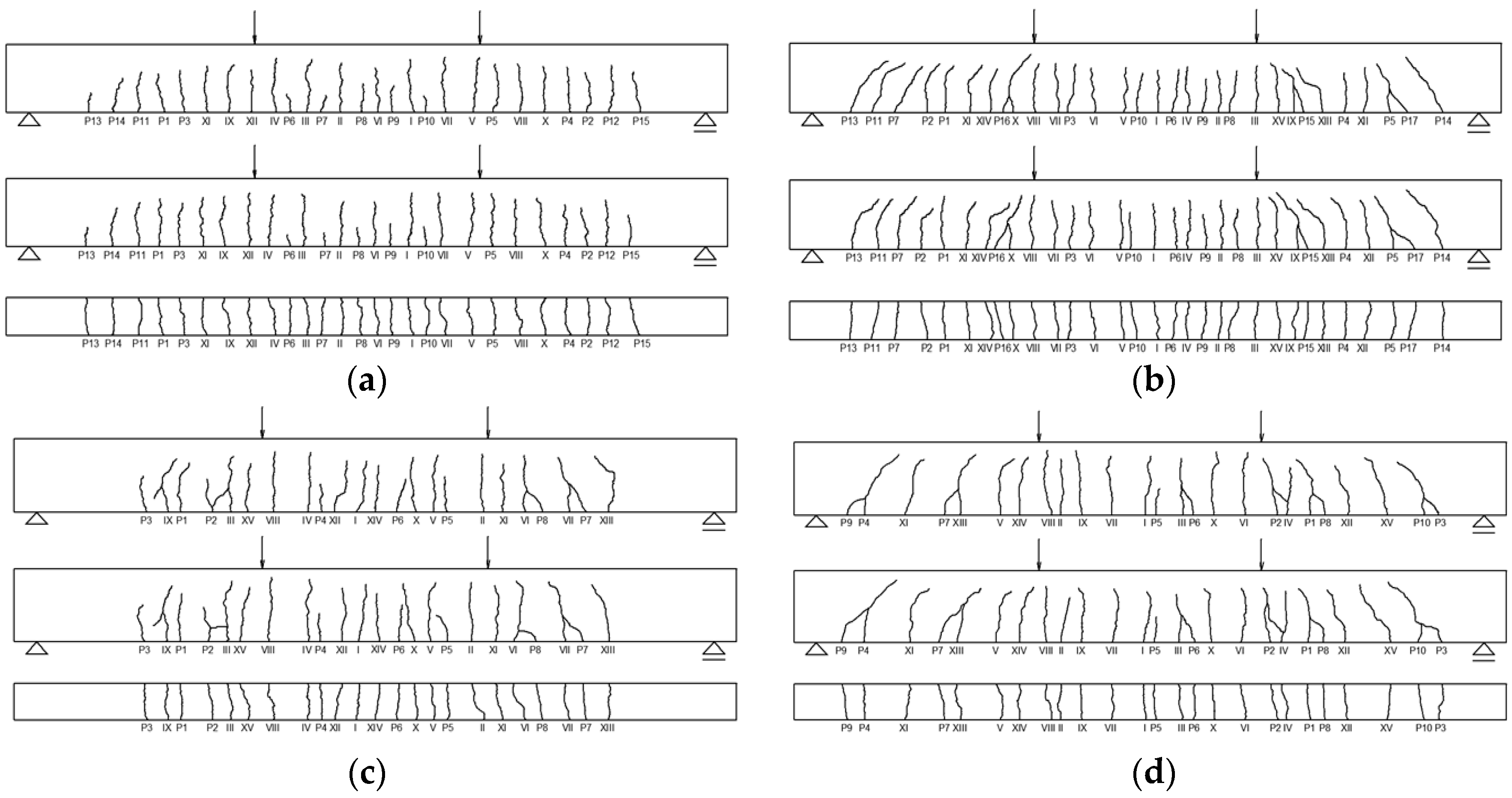
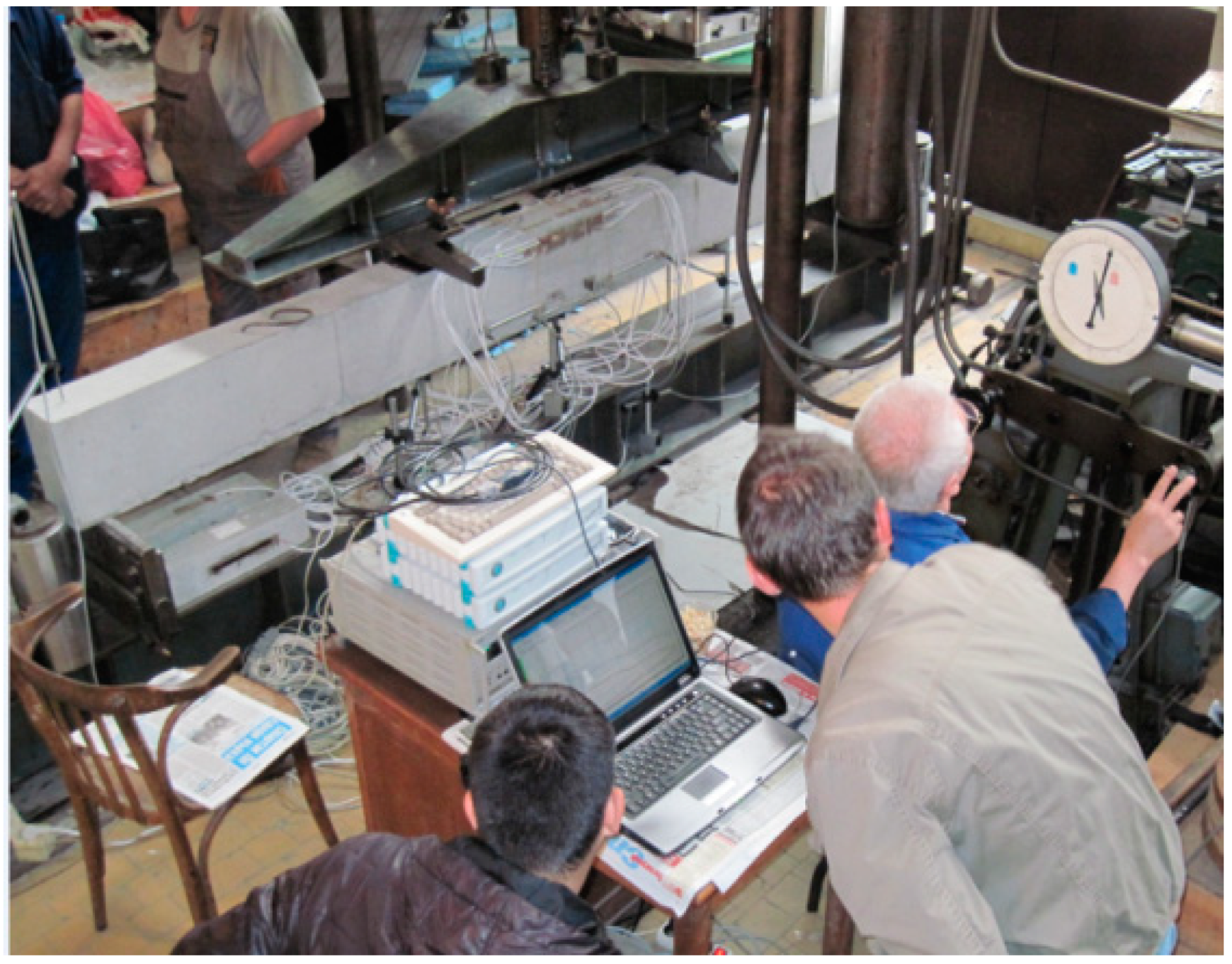
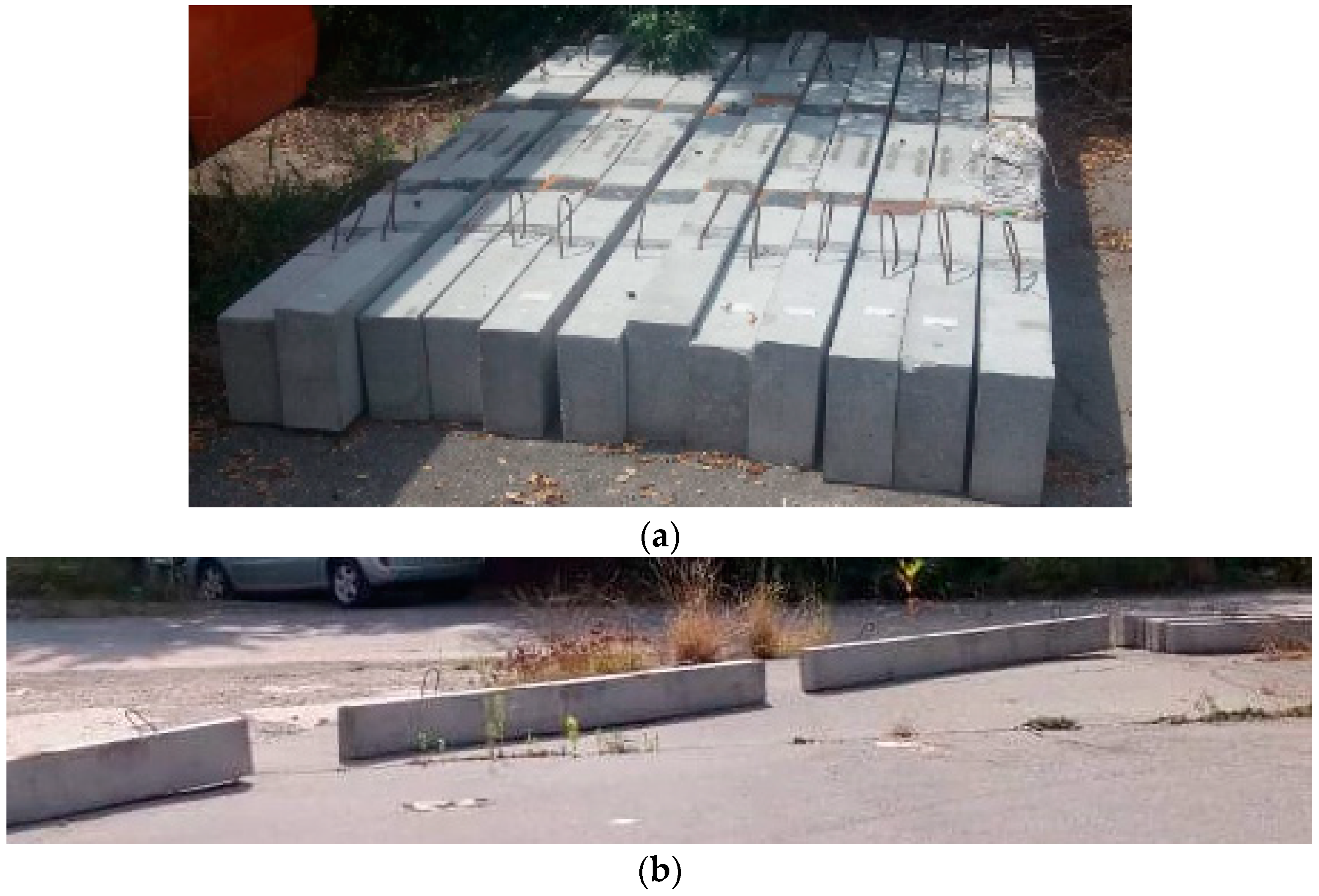
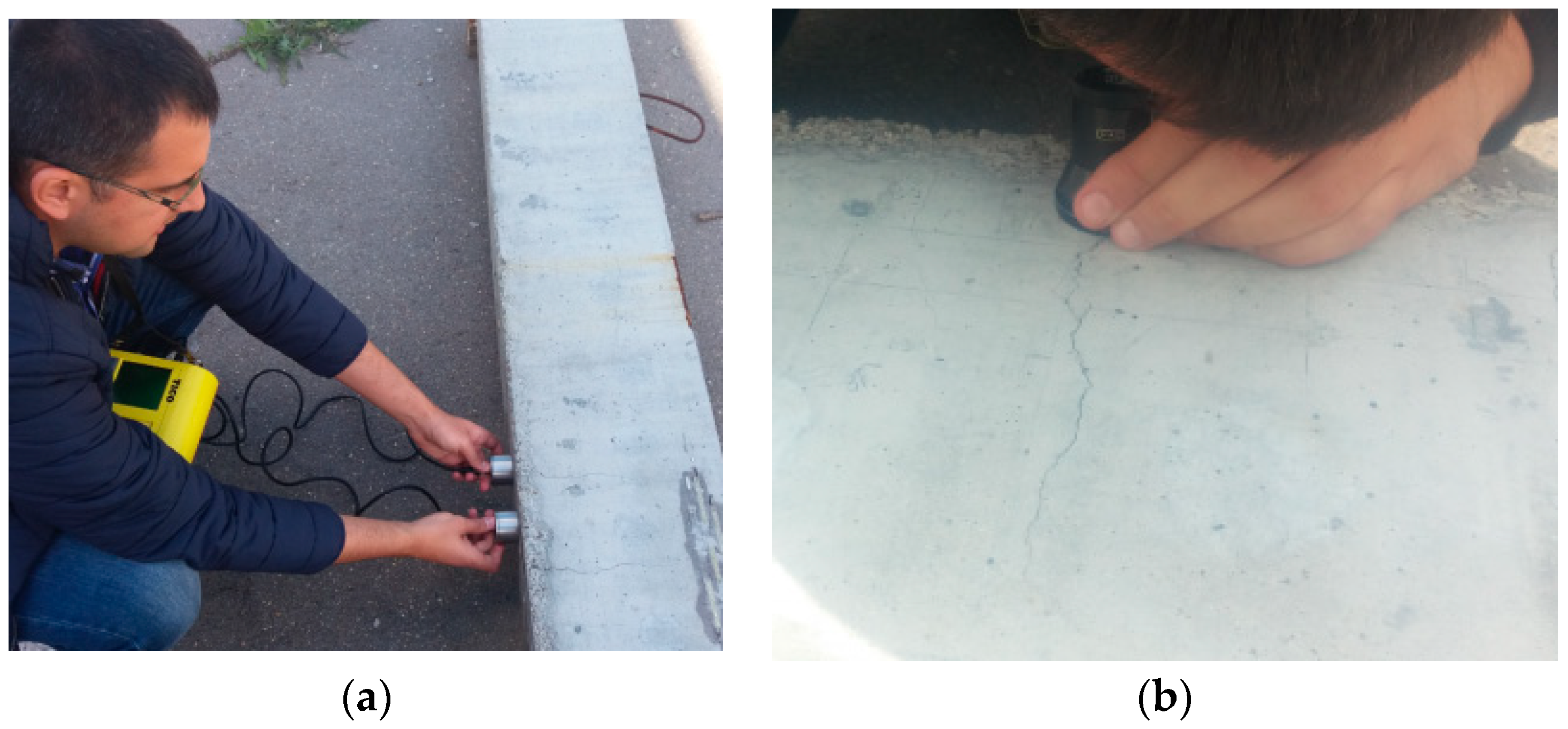

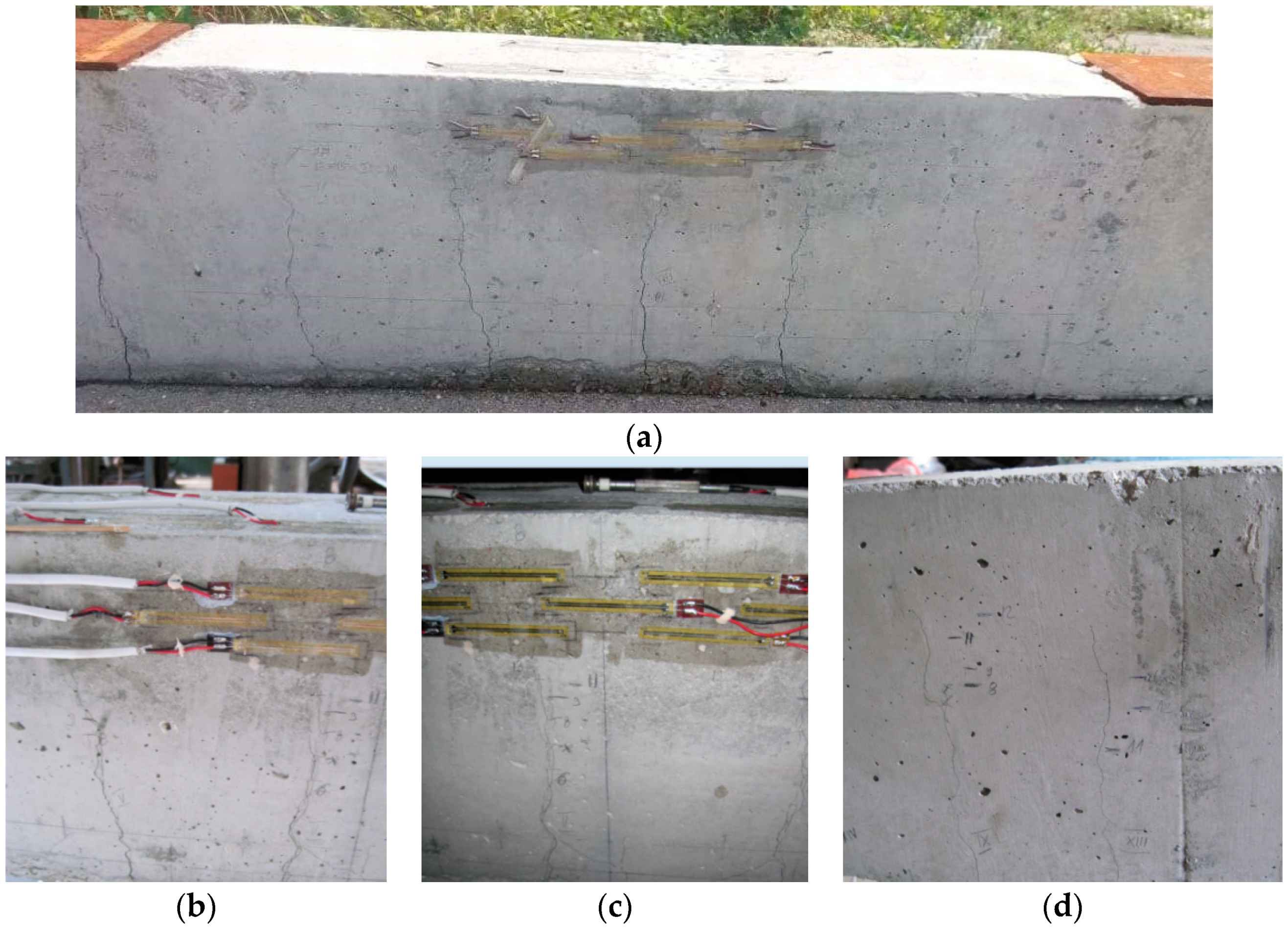
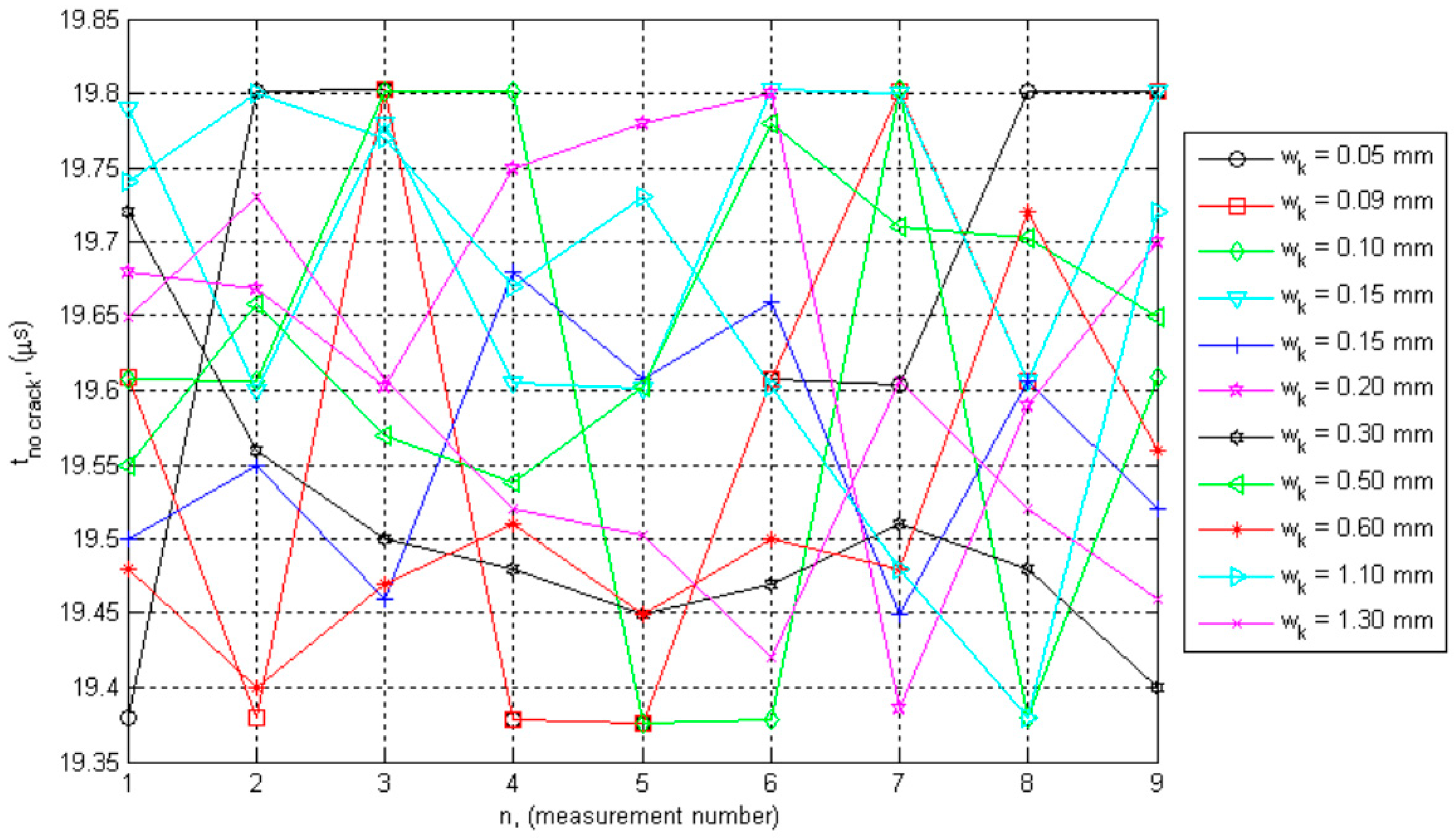
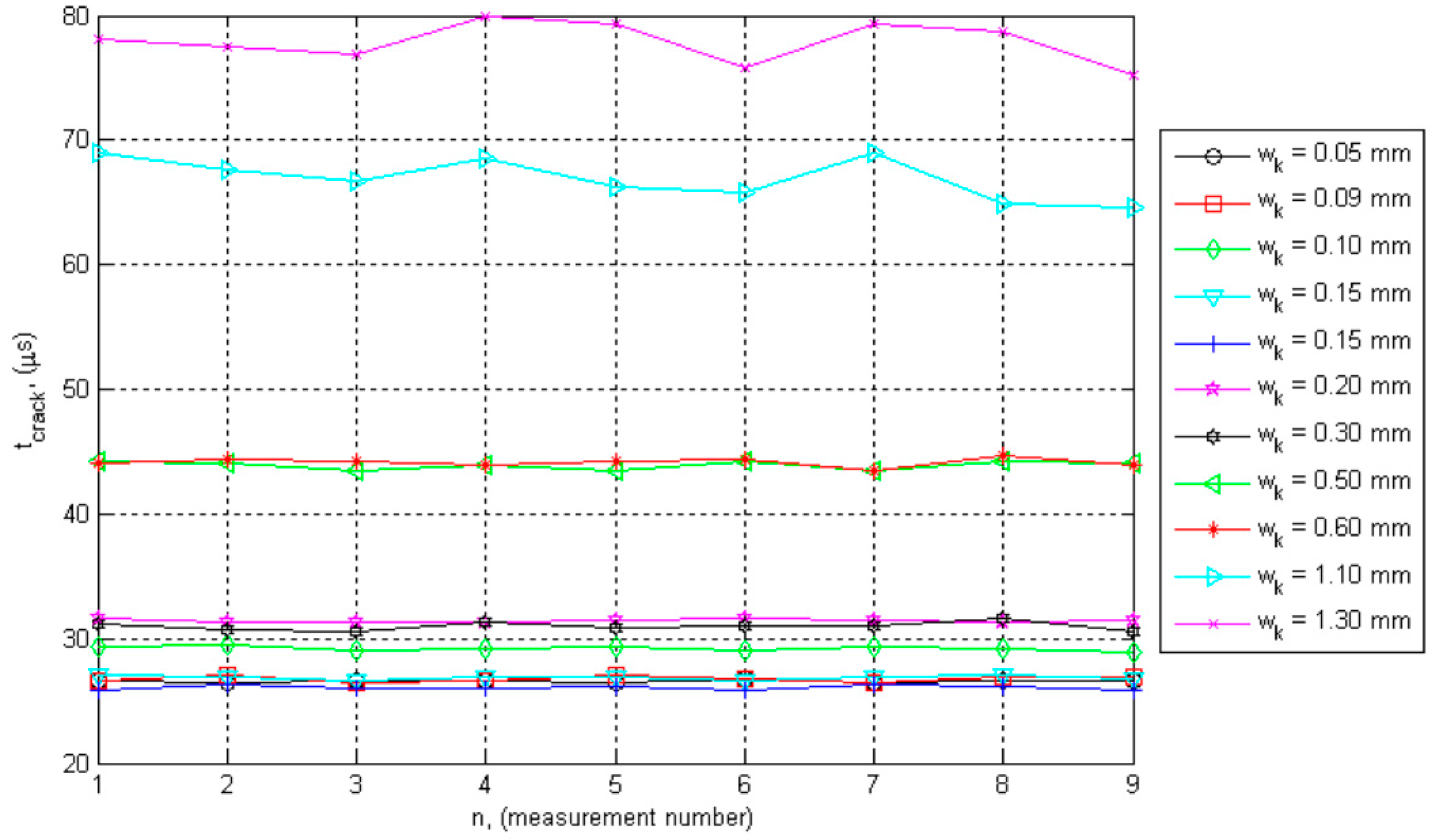
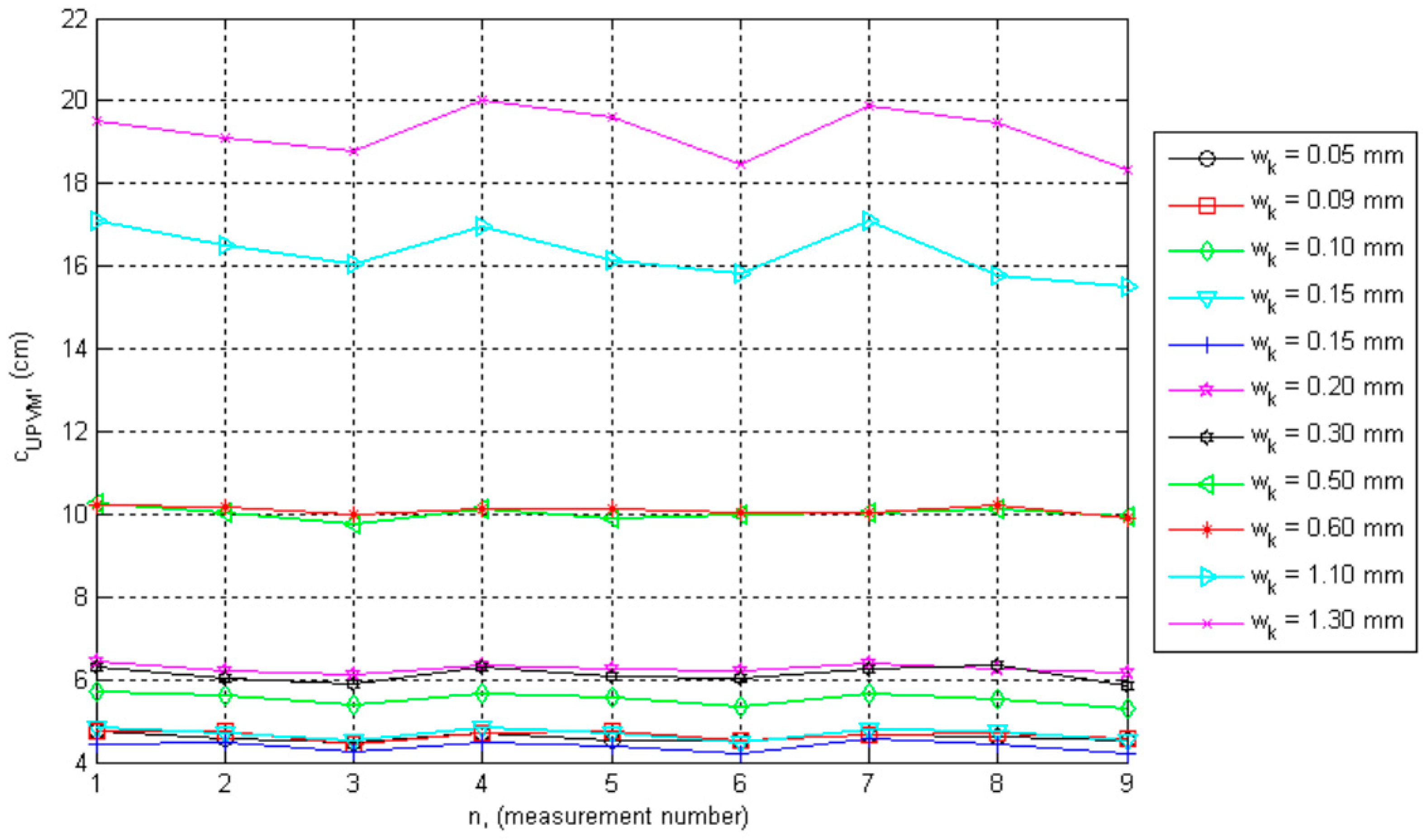
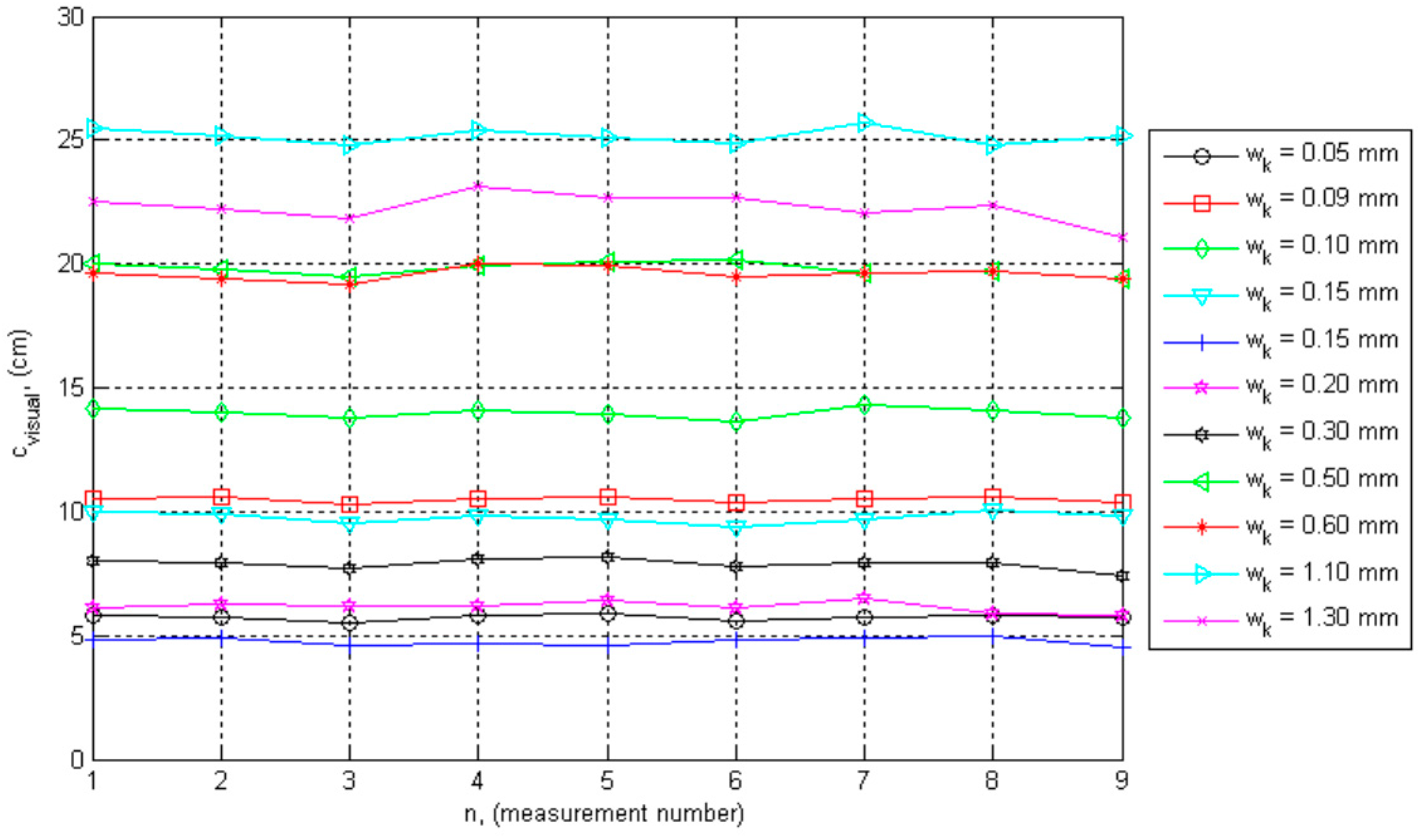
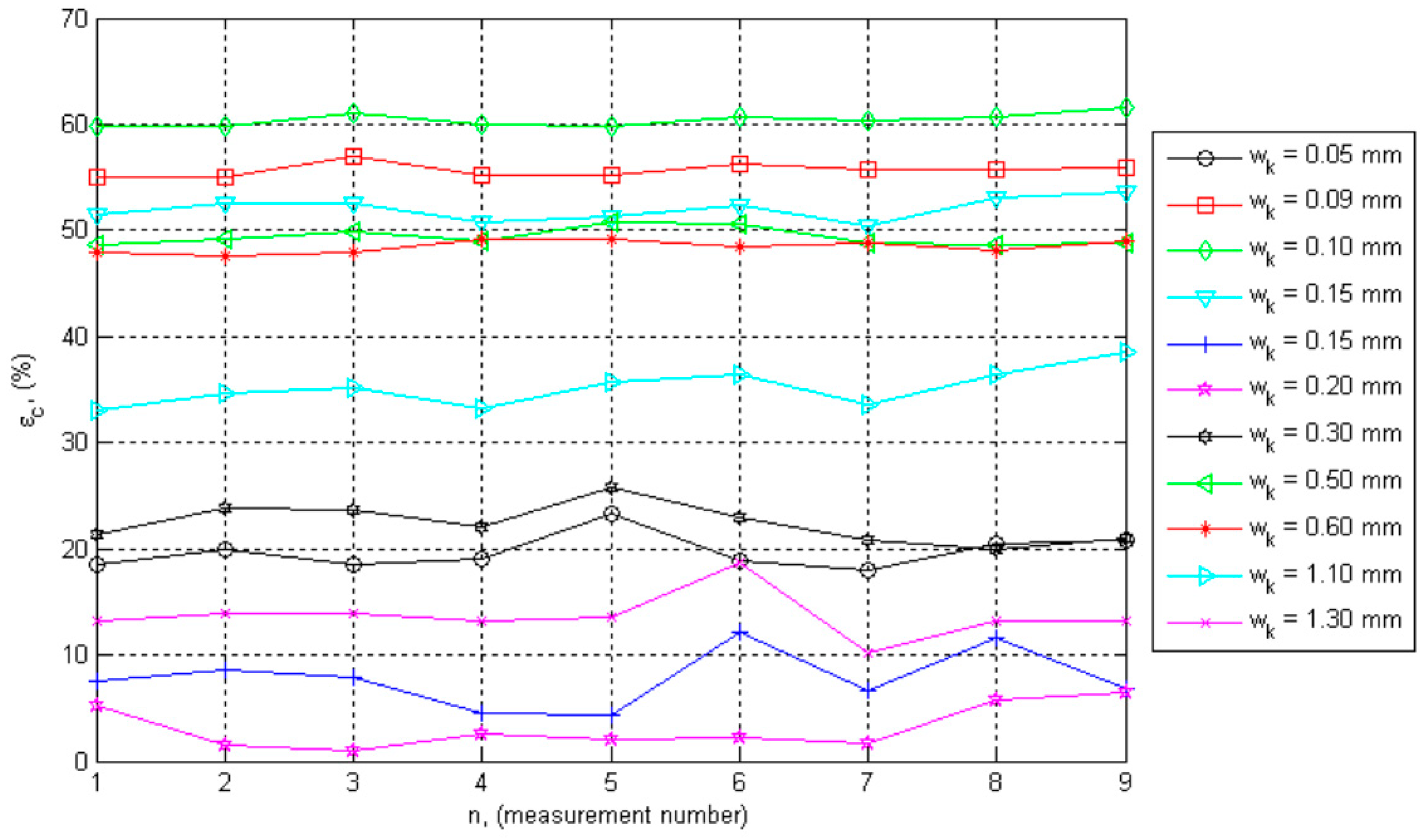
| 0.05 | 0.09 | 0.10 | 0.15 | 0.20 | 0.30 | 0.50 | 0.60 | 1.10 | 1.30 | |
| ) | 26.74 | 27.10 | 29.50 | 27.03 | 31.65 | 31.65 | 44.25 | 44.64 | 68.97 | 80.00 |
| 26.46 | 26.46 | 28.82 | 25.84 | 31.25 | 30.49 | 43.48 | 43.48 | 64.52 | 75.19 | |
| 26.60 | 26.76 | 29.22 | 26.46 | 31.43 | 30.96 | 43.90 | 44.14 | 66.90 | 77.89 | |
| 0.09 | 0.23 | 0.22 | 0.44 | 0.12 | 0.36 | 0.34 | 0.36 | 1.69 | 1.68 |
| 0.05 | 0.09 | 0.10 | 0.15 | 0.20 | 0.30 | 0.50 | 0.60 | 1.10 | 1.30 | |
| 4.73 | 4.77 | 5.71 | 4.86 | 6.42 | 6.33 | 10.26 | 10.23 | 17.08 | 20.03 | |
| 4.48 | 4.43 | 5.29 | 4.19 | 6.14 | 5.85 | 9.77 | 9.88 | 15.50 | 18.31 | |
| 4.59 | 4.65 | 5.53 | 4.54 | 6.27 | 6.12 | 10.02 | 10.09 | 16.33 | 19.24 | |
| 0.09 | 0.11 | 0.16 | 0.21 | 0.10 | 0.19 | 0.15 | 0.11 | 0.60 | 0.61 |
| 0.05 | 0.09 | 0.10 | 0.15 | 0.20 | 0.30 | 0.50 | 0.60 | 1.10 | 1.30 | |
| ) | 23.22 | 56.99 | 61.67 | 53.67 | 6.38 | 25.85 | 50.75 | 49.25 | 38.49 | 18.68 |
| 18.07 | 54.95 | 59.78 | 4.35 | 0.97 | 19.87 | 48.68 | 47.58 | 33.02 | 10.14 | |
| 19.73 | 55.68 | 60.43 | 29.90 | 3.15 | 22.35 | 49.37 | 48.48 | 35.17 | 13.68 | |
| ) | 1.63 | 0.67 | 0.67 | 22.84 | 2.05 | 1.87 | 0.82 | 0.62 | 1.78 | 2.19 |
© 2019 by the authors. Licensee MDPI, Basel, Switzerland. This article is an open access article distributed under the terms and conditions of the Creative Commons Attribution (CC BY) license (http://creativecommons.org/licenses/by/4.0/).
Share and Cite
Ivanchev, I.; Slavchev, V. About the Possible Limitations in the Usage of the Non-Destructive Ultrasonic Pulse Velocity Method for Assessment of Cracks in Reinforced Concrete Structures, Subjected to Direct Environmental Exposure. Buildings 2019, 9, 202. https://doi.org/10.3390/buildings9090202
Ivanchev I, Slavchev V. About the Possible Limitations in the Usage of the Non-Destructive Ultrasonic Pulse Velocity Method for Assessment of Cracks in Reinforced Concrete Structures, Subjected to Direct Environmental Exposure. Buildings. 2019; 9(9):202. https://doi.org/10.3390/buildings9090202
Chicago/Turabian StyleIvanchev, Ivan, and Veselin Slavchev. 2019. "About the Possible Limitations in the Usage of the Non-Destructive Ultrasonic Pulse Velocity Method for Assessment of Cracks in Reinforced Concrete Structures, Subjected to Direct Environmental Exposure" Buildings 9, no. 9: 202. https://doi.org/10.3390/buildings9090202
APA StyleIvanchev, I., & Slavchev, V. (2019). About the Possible Limitations in the Usage of the Non-Destructive Ultrasonic Pulse Velocity Method for Assessment of Cracks in Reinforced Concrete Structures, Subjected to Direct Environmental Exposure. Buildings, 9(9), 202. https://doi.org/10.3390/buildings9090202




